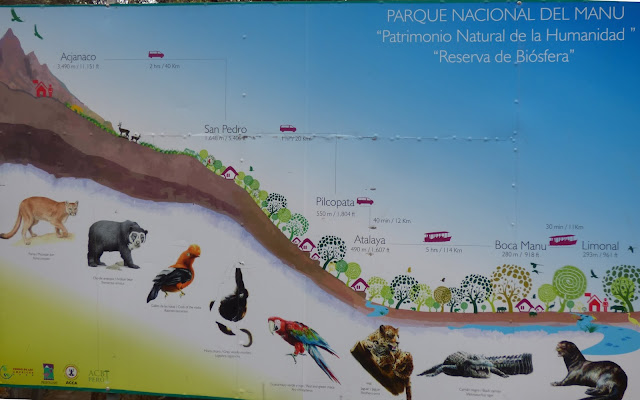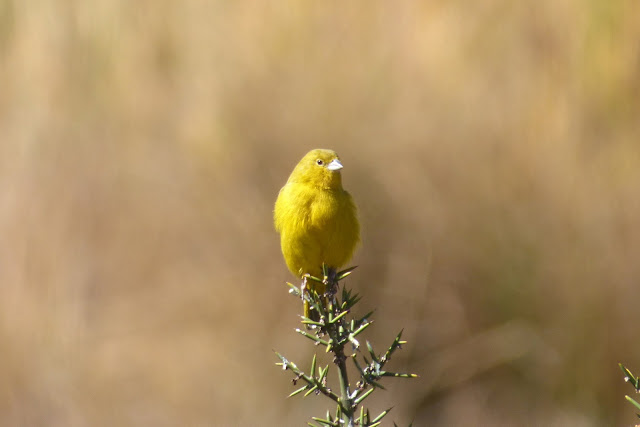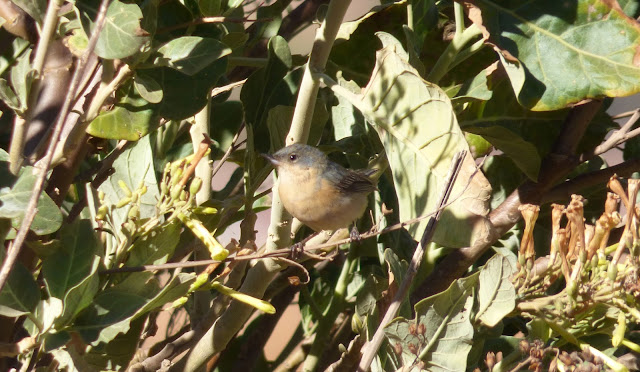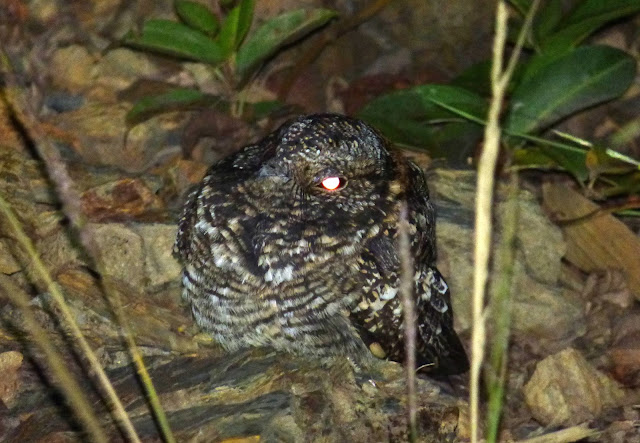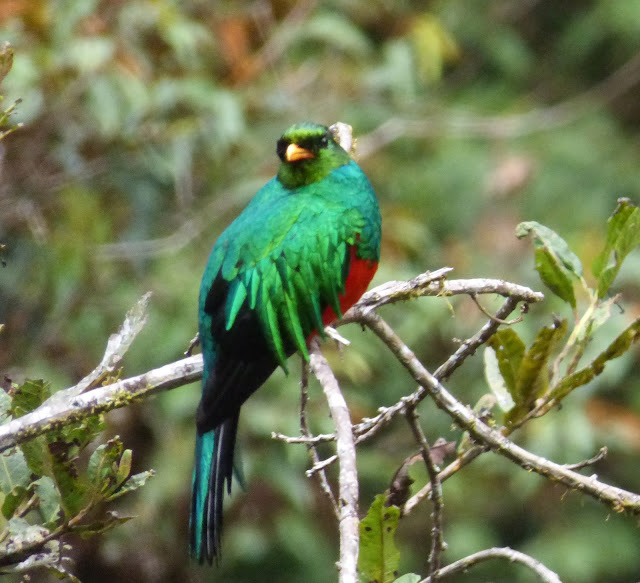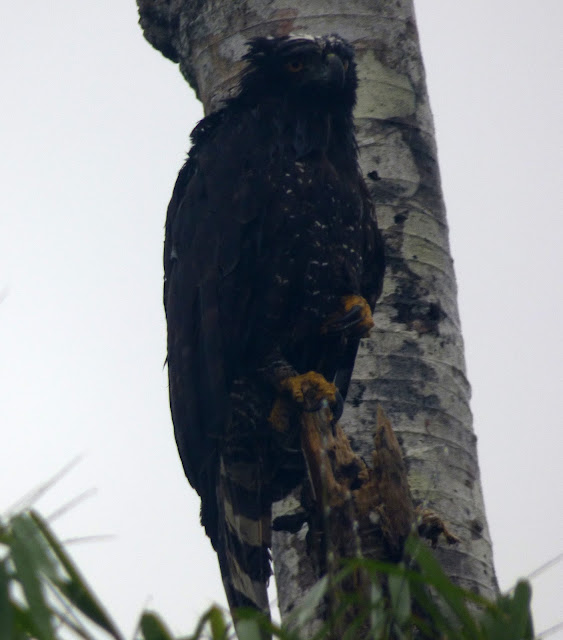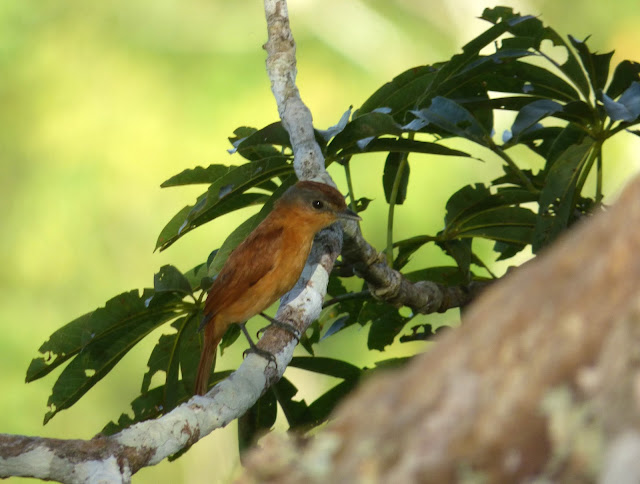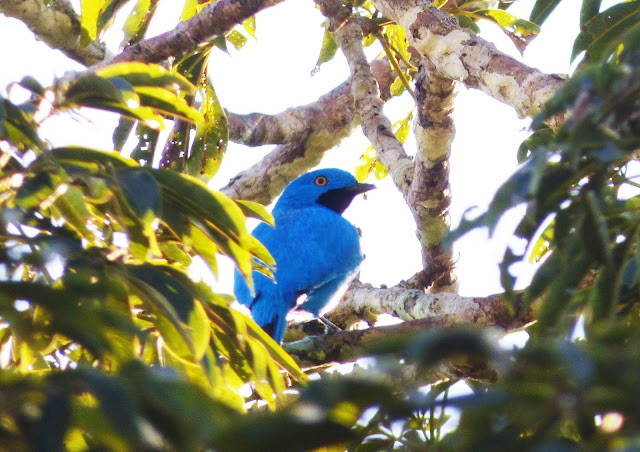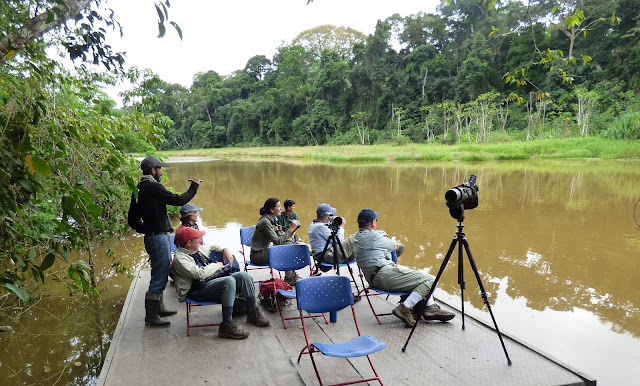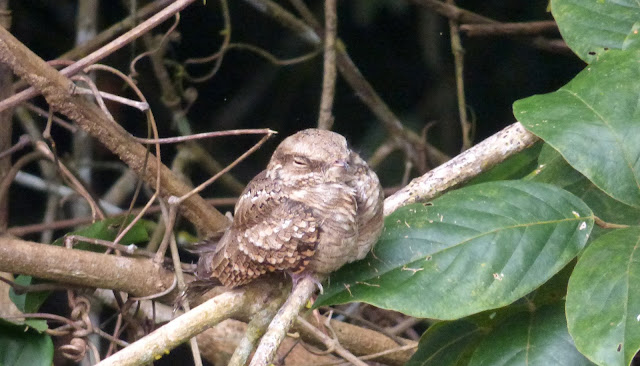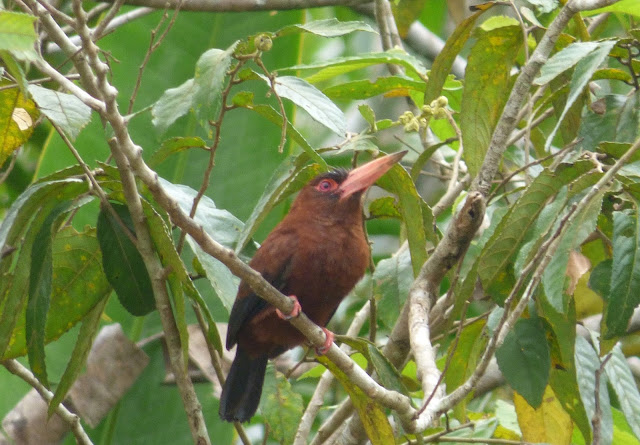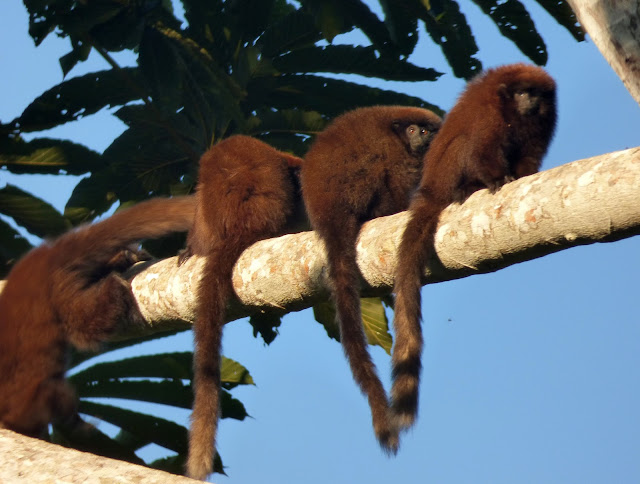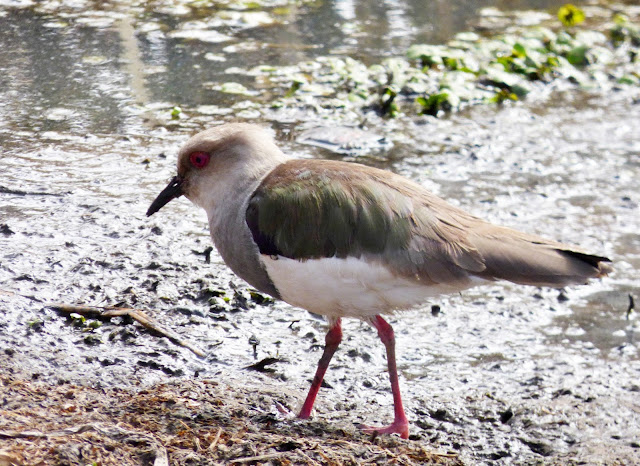“The going isn’t always easy” -The Lonely Planet Bolivia
Natalia and I left Peru naively expecting more of the same from Bolivia: great birds; great food; great people. The chaotic border crossing portended the many challenges that were to come. In fact, the pitfalls nearly outshone the bird life.
What? You came here for birds? We did too. See Bolivia seems great for birds on paper: 1400+ species and some 25 endemics, plus 18% of the country is protected areas such as national parks. But as is the case in many developing countries protected area borders exist only on maps and to Bolivians on the ground do not actually exist. And even the birdiest, most attractive parts of the country are completely lacking in conventional tourist infrastructure.
We entered Bolivia on the shores of Lake Titicaca at the
“picturesque” town of Copacabana (photo purposefully omitted; the town did not
inspire me to take out my camera).
It’s telling that Lake Titicaca, a geographic feature
two-thirds of which lies within Peruvian borders, is nevertheless featured on
the cover of the Lonely Planet Bolivia.
Our first Bolivian adventure began before we even made it to
La Paz. We and our bus had to cross a section of the lake by ferry. We did not
imagine that passengers and bus would have to make the journey separately. But
in hindsight we were glad of this arrangements.
 |
| Ferry crossing of Lake Titicaca. That's our bus with all our luggage being pushed over on a wooden barge by a guy with an outboard motor. |
Titicaca Grebes were thick in
this area of deeper water and Andean Gulls hovered over our heads looking for
handouts as we motored across in the chop.
Onward the landscape was dry and desolate. Bird life seemed to concentrate at the small
creeks and streams we passed over. We had a glimpse of some Andean Avocets in
one.
Having read about La Paz on the bus ride there, we managed
to convince ourselves that the best strategy for birding and enjoying La Paz would be to get the hell out as soon as possible. So we
arrived in the evening and were out again on a cheap flight the next morning to
Cochabamba.
Cochabamba is also high and dry, but at 3000 meters is
significantly lower than La Paz’s nose-bleed-inducing 3600. We set out
immediately to check out what birds were to be had at Laguna Alalay, a large lake in the middle of town. The lakeside was a desolate destruction zone. Clearly the government had cleared trash and
vegetation from the waterfront in some sort of effort to make it appealing for
visitors, but hadn’t yet gotten around to putting anything in its place. So the whole area had the feeling of a vacant
lot.
We came across a man defecating, who, bare-assed, was
summarily apprehended by two women on security patrol. As we gazed in the
opposite direction out at the lake to spot Andean Ruddy Ducks and White-tufted Grebes we were
surprised when the security approached us.
“Do you have permission?”
“Permission is needed to look at birds here?”
“Yes, everyone must obtain permission. Head to the security
station over there.”
Obligingly we walked along the dirt over toward a distant
building where requesting permission consisted of writing down our names and
passport numbers in a notebook. The security team offered to send an escort
with us on our hike. It did seen a bit
sketchy around the lake, and the hotel staff had warned us to be careful, but
Natalia explained how boring and slow birdwatching would be for our guard and
so we carried on alone.
Despite the rather unpromising context, there were birds
everywhere and most of them were new and unidentifiable to us, which was
exciting. Remember, Bolivia has no bird
book. We had our Peru and Argentina guides as well as a Southern South America
‘illustrated checklist,’ but Bolivia is such a mashup of ecosystems that it was difficult to figure out which book to refer to. Compounding matters is the fact that the illustrations in the Argentina
and Southern South America books are so atrocious as to be nearly unusable for identification. The Flycatcher sp. conundrum,
already fraught with a good guide, is next to impossible in Bolivia.
I resorted to a shoot-first and ask-ID-questions-later
birding strategy, relying heavily on the camera.
 |
| Rufous Hornero, Cochabamba |
After reaching the end of a populated area along the lake shore, we decided to double-back rather than continue around a bend into a promising-looking more-vegetated area. There were
a lot of sketchy-looking teens roaming about giving our optics long looks.
Stolen binoculars in Bolivia would be catastrophic.
Back at the security kiosk, we ran into a scientist from the
Ministry of the Environment, who informed us that she was there to investigate
a recent massive bird die-off. The water was a putrid pea-soup
green and the lake shore was littered with garbage, plus we had already seen
how it functioned as a public toilet. The scientist's main challenge was that the trail was
cold. It had taken Bolivia’s corrupt
bureaucracy two months to approve her visit to Cochabamaba from La Paz. How was
she going to figure out the source of the problem so long after the fact? For a scientist investigating bird health, she didn’t seem to be much
interested in birds. I interrupted her once to point out a hawk flying
overhead. She gave it a half-glance before continuing her rant.
Here’s my photo:
 |
| unidentified hawk. Cochabamba |
I still can’t figure out what the heck it is!
This experience of finding Bolivians indiffent toward both
tourism and natural resources would become a recurring theme of our time in
country.
Later that afternoon we visited the local access to Tunari
National Park, a crescent that encircles the Cochabamba valley designed to protect
the population’s water supply. The taxi driver had no idea what the park was or
how to get there, so we guided him using the GPS on one of our phones.
When we arrived the entrance kiosk (to ask ‘permission’ as
were now trained to do), the woman explained to us that nobody can enter after
3 o’clock and seeing as it is now 3:02, we would not be allowed to proceed. We
managed to talk our way past this absurdity. Afterall we would not be very far
from the entrance anyway.
The landscape here was arid scrub and loaded with new and
interesting birds. We spent two hours at the end of one switchback in the road
overlooking a dry gully as hummingbirds, warbling-finches and other birds moved
up the mountain while the sun dropped.
We managed to get out by closing time, as promised, and
caught a public buseta back into town for about 35 cents.
We had arranged with our taxi driver to pick us up the
following morning at 4 am to take us up to a higher access to the park. We made
it to the bridge spanning the river at 3600 meters just after dawn and
immediately found our main target in a Cochabamba Mountain-Finch, one of
Bolivia’s endemics. From here we birded our way back down the road to 3100
meters over the course of 5 hours. We saw some great birds.
 |
| Andean Hillstar, Tunari National Park |
 |
| Rufous-bellied Mountain-Tanager, Tunari National Park |
 |
| Rufous-bellied Bush-Tyrant |
 |
| Golden-billed Saltator |
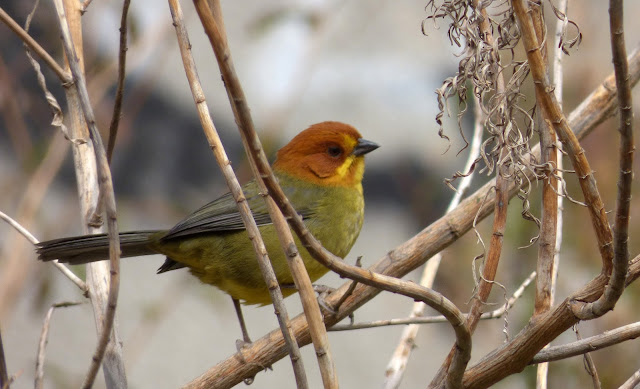 |
| Fulvous-headed Brush-Finch |
But sadly Tunari, like many of its kind in the developing
world, is a National Park in name only. As we descended, the scale of the
degradation grew steadily more intense. All manner of rubbish began to pile up
along the sides of the road: tires; plastic bags; months supplies of used diapers. In the absence of public sanitation services
it seems that people have been using the park as a public dumping ground. Ironically, the motivation for this park was to protect the city’s watershed. Hillsides of endangered polylepis forest had been cleared to make way for
fields of potatoes and flowers. The silver lining is that the inaccessible
opposite side of the river appeared to still be pristine.
In retrospect, I’m curious as to what we would have found if
we had birded our way up slope instead of down. A lot of odd birds I’ve never
seen occur in these high Andean landscapes. Down was our only real choice
though, as a harsh wind gave us the shivers and we were way under-dressed for
the near-freezing temperatures. It’s
hard to get a good temperature forecast and the difference was far greater than
altitudinal lapse rates would have suggested.
We thanked and tipped our very friendly taxi driver, who had
charged us a cool ~$40 for his morning’s work (what a deal!).
No rest for the wicked… that afternoon we hopped a
collectivo that took us all the way from the high Andes down into the Amazonian
foothills in one hop.
It’s a bit frustrating because you know there could be
excellent birding all along this route spanning 2700 m in elevation, yet there
are neither roads, nor lodges, nor guides. The real missing raw ingredients in
Bolivia, however, are a culture that values nature and hospitality. Apart from
perhaps Haiti, Bolivia may be the New World country that is least prepared for a birder or ecotourist. Unlike Haiti, however, Bolivia has loads of intact
ecosystems, so there is hope for the future.
And I dare say there’s a huge opportunity here. Eventually, North
American birders will begin venturing to South America en masse as birding
rises in popularity and a new generation, more bilingual, less xenophobic, and
less-beholden to the ABA’s idiosyncratic borders emerges. After so many trips to
Colombia, Ecuador and Peru, Bolivia is the required destination if one hopes to
sample the complete buffet of birds that the tropical Andes has to offer.
Anyway, we arrived in Villa Tunari exhausted and agreed to
allow ourselves to sleep-in for a morning. We didn’t have any good birding
strategies lined up yet anyway.
 |
| White-necked Puffbird, Villa Tunari |
From the excellent online trip reports of birdsbolivia.com, we learned that the best birding near this 'touristic' town was a couple hours back up the road from which we had just come. On the highway that connects Cochabamba and Villa Tunari, a road follows a Chinese hydroelectric pipeline down a ridge starting at roughly 2000 m into what is supposedly some of the most-accessible mid-elevation Yungas habitat in all of Bolivia. The habitat is called ‘cloud forest’ by everybody in the world, except in Bolivia where it is called ‘Yungas.’ Actually, on this particular road, many people would call it ‘crap’ because it has been heavily degraded and cleared for cultivation.
Our driver arrived half an hour late, leaving us waiting in the dark at our hotel (gotta love that Bolivian service!), so we missed the best early dawn birding. Nevertheless, as soon as we found some decent forest along the road, there was a nice mixed-species flock with Saffron-crowned Tanagers, Montane Woodcreepers, Variable Antshrike and others. By the time we had birded our way through the flock and caught a glimpse of one of our main targets in a Yungas Manakin, it was 9 am and in the unusually bright day, the birds went dead. We kept at it for another hour and a half and caught up with a Streak-throated Bush-Tyrant, Slaty Elaenia and some Green-Cheeked Parakeets, but decided to head back down the mountain so we could grab lunch before our scheduled trip to an Oilbird cave. Not so fast.
As we came back out to the highway we found ourselves as front-row witnesses to a recently ignited ‘bloqueo’ protest, with burning tires and logs. We were told some of the locals were protesting a trout fair. Thus the highway connecting two of Bolivia’s largest cities was suddenly rendered useless. We waited a bit with our driver, but he advised us to descend on foot and catch a ride with somebody turning back from the blockade. As we passed by the crowds of angry truckers and onlookers, some whoops of excitement rang out it was announced that the blockade would be removed in ten minutes.
The two-lane Andean highway now had three lanes of traffic at loggerheads, and blockade or not, there would be no progressive movement anytime soon. So we continued walking downhill several kilometers spreading the news to anxious truckers and bus passengers.
Yes, there was a blockade. Yes they are clearing it. But no, you will not be going anywhere anytime soon because of overtaking cars clogging the highway.
‘Porque son desobedientes!’ one grumpy trucker exclaimed.
True, irresponsible aggressive passing makes a 1-hour blockage into a day-long ordeal, but it’s the trucks, which achieve a maximum speed of approximately 10 kilometers per hour on the steep grades and tight curves that make a suicidal driving strategy not insane, but rather a practicality.
After a few hours we eventually caught a ride in a backtracking minivan with seats available.
Inside it, of all people, was the craziest U.S. ex-pat I’ve come across in all my international travels. He was full of impossible juxtapositions. One minute giving prudent travel advice, the next extolling the virtues of drunk driving in Bolivia, because of the easily bribe-able police. Then he would be bemoaning his poor real estate investments via eBay and in the same breath extolling the upside of his pending Nevada marijuana farm. Before the mental red flags could reach full mast, he was already hawking the iPhone app he is ‘developing’ to block negative electronic frequencies that damage the brain.
He was travelling with his Bolvian wife and two infant children. After tenderly comforting his two-year-old son, ‘Ludwig Jr.,’ he would go on to recount his drunken fight with the intelligence police in La Paz and how his mother had to fly down from the U.S. to pay off the judge and bail him out of jail. Just when I was beginning to think he was one of those compulsive liars who can’t distinguish between true life experiences and fantasy, he got a call from a client. Turns out he was running some sort of paralegal advice service through his phone.
Anyway, we made it back to Villa Tunari in the mid-afternoon and gave a hasty farewell to Ludwig. The bloqueo had scuttled our plans to visit the nearby Oilbird cave, but at least we hadn’t tried to stick it out with our driver who didn’t make it down until after dark. We would read in the paper the following day that the military police had arrived to forcefully remove the blockade using tear gas, but this is blatant state propaganda. With the bloackade intact it would be impossible for any police trucks to arrive at the scene; and we saw the blockade being removed shortly after it had been put in place. What I can only assume really happened is that once traffic began moving, the police showed up to tear gas the local residents as punishment. The article ominously quoted a government official stating that rumors of gunfire used by police on unarmed civilians were untrue. Yep. That doesn’t sound the least bit concerning. Bolivia!
So we escaped the bloqueo and tear gas, but some Bolivian suffering would catch us as we attempted to leave town.
I present to you: the Bus Ride From Hell
The guy in front of me had wrenched his seat so far back that his
head was in my lap. Bolivian buses,
being designed for a less-vertical demographic, leave little in the way of leg
room for somebody taller than six feet.
I had no choice but to twist sideways and sprawl my legs into the aisle.
Some time later, I awoke to a woman savagely pinching my legs. ‘mueve las piernas.’
All I could mutter in dazed half-sleep was ‘no puedo,’ which was nearly
accurate.
Nevertheless, the next words that came out of the woman’s
mouth, who was now vigorously shaking my inert shins, were a bit of a surprise:
‘Estan encima de la cabeza de mi nina!’ I pulled my feet back before I could
comprehend what had been said: they are on my daughter’s head.
In the dark jouncing of the bus these words, though a harsh
whisper, reverberated. My vision was
mostly obscured by a jacket wrapped around my head (an attempt to dull the
awful neck pain inflicted by a head rest that barely reached the bottoms of my ear lobes), but I
could sense the old crone in the opposite row concocting her worst of
curses and aiming it in my direction. It was the one she saves for the worst gringos. The kind who kick little girls in the head.
Sure enough within a couple hours, whether by karma or by
curse, I awoke again with the most excruciating intestinal pain.
By this point it seemed as though we must be nearing Santa
Cruz, judging by the density of lights and buildings outside. If I could just hang on, I might make it off
the bus without shitting my pants and really becoming the most popular
passenger on the bus ride from hell.
So this is the part of the bus ride that makes the least
sense: No, not the gross over-booking, not the children sleeping in aisles and
getting occasionally stepped on, but the unique departure time of 8 pm. This is the only time one can take the
7-hour bus trip from Villa Tunari to Santa Cruz. I repeat, buses leave at no
other time of day or night.
So here we were cruising into the Bolivia’s most populous
city at 2:45 am… miraculously an on-time arrival! Yet, instead of opening the doors
and letting everybody off at the station to blearily make their way home or
wherever, the bus pulled into a sketchy-looking alleyway and parked. Apparently the bus terminal doesn’t become
safe until 6 am, so we were given the choice to wait on the bus another three hours or
chance it in the risky alley and hope to find an honest taxi driver before
getting taken out by a mugger.
There are many nice Bolivians, who I’ve been lucky to meet while
travelling through this mess of a country, but our bus driver was not one of
them. Friendly, helpful Bolivians can be damn scarce country-wide, even in the
places where you would expect to find the cream of the crop, such as hotel
receptions or taxi stands in touristic places.
There just don’t seem to be very many people who work service jobs with
what one might consider to be a service mentality. The rub isn't that they have a bad attitude or
charge inflated prices to tourists. No, Bolivians just don’t seem to have any
interest in helping a tourist even when there is good money to be made.
Anyway, we found an honest taxi driver who was actually
rather good to us. No he didn’t know
where our hotel was, but didn’t complain while spending the better part of an
hour driving circles around neighborhoods looking. In Bolivia only major
arteries have street signs and taxi drivers don’t carry phones or any
navigational aids.
So we made it. At 3:30
am. I slept for the subsequent 27 hours.
So that was the Bus Ride From Hell. You came here for birds (we did too), but as the Lonely
Planet puts it. “Bolivia will test your patience and stamina.” So if you made
it this far, congratulations! Maybe you
too have the endurance to bird Bolivia.
The Santa Cruz Botanical Garden offers a promising
remnant of dry forest, but the 20 to 30 mph winds made the birding tricky. We
got Ocellated Piculet and watched some Least Grebe chicks get devoured by a
caiman.
 |
| Prolific sloth-watching is there to be had at the Santa Cruz Botanical Gardens. We saw three. |
We were determined to find a pleasant birding experience somewhere in Bolivia and Los Volcanes proved to be the ticket. Just a few hours drive from Santa Cruz, it isn't terribly difficult to access and the setting is gorgeous.
 |
| Guest House at Los Volcanes |
This little gem owned by a German family sits in a pristine mesic forest in the buffer zone of Amboro National Park. It has trails, friendly hosts and great food.
 |
| Two-banded Warbler, the most ubiquitous bird at Los Volcanes |
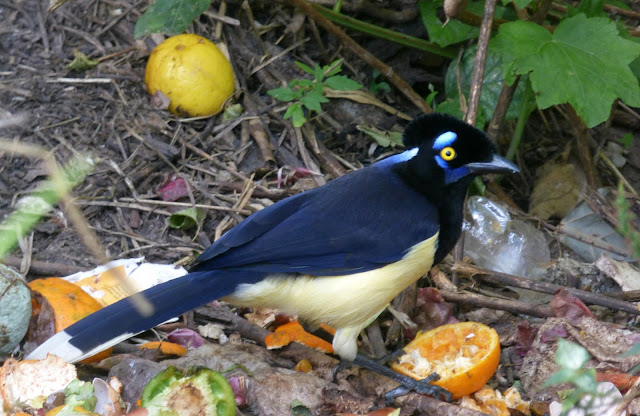 |
| Plush-crested Jay, the second-most ubiquitous bird at Los Volcanes |
If it just had a few banana and nectar feeders, it would be the full neotropical birding lodge experience. Fortunately, we don't mind working for our birds.
 |
| Amazonian Motmot |
 |
| Black-banded Woodcreeper |
 |
| Black-goggled Tanager |
Los Volcanes was hard for me to characterize. The forest isn't quite wet and it isn't quite dry. And the Avifauna are part Amazonian, part Andean. It's the only place where I've seen both Andean Condor and King Vulture.
 |
| Chestnut-eared Aracari |
There's lots of bamboo in the area. Although we dipped on Bolivian Recurvebill, the bamboo seeds brought in raucous flocks of parrots.
 |
| Mitred Parakeet |
 |
| Green-cheeked Parakeet |
Three fulls days to bird Los Volcanes was plenty. By the end we had nearly run out of targets. We only knew this because ornithologists had put together an annotated checklist of the local bird life (very useful!).
Back in Santa Cruz we had fun on our last morning in Bolivia at Lomas de Arena, a site characterized by some huge sand dunes. We wanted to actually stay at a lodge on site, but nobody answered any of the 4 phone numbers we found for them and they didn’t reply to our emails (now that is how you run a business!). We hired a taxi to take us out there and he promptly got stuck in the sand. No problem we’ll head out and begin birding by foot. Everybody said it never rains in Santa Cruz this time of year, so of course we were unprepared for the ensuing rain and cold. The expectation was dry and brutally hot.
We would take refuge where we could and then bird between showers.
 |
| a very soggy Burrowing Owl, Lomas de Arena |
 |
| Campo Flickers, Lomas de Arena |
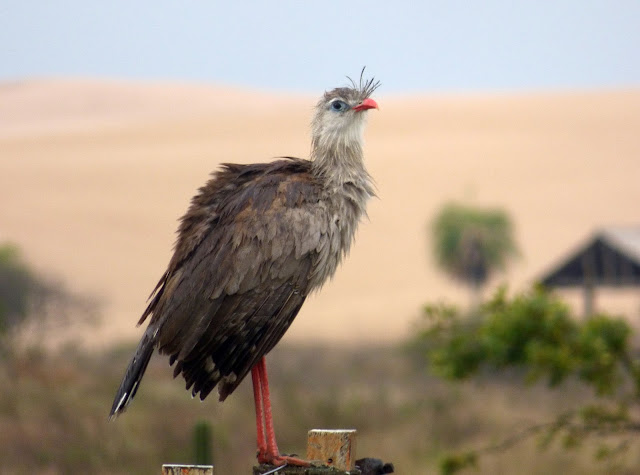 |
| Red-legged Seriema, Lomas de Arena |
The taxi driver managed to un-stick himself and picked us up
several hours later. We never made it to the lagoon that was supposed to be
full of birds and somewhere near the sand dunes. But we weren’t too bothered
since wetland birds were unlikely to be new for us anyway. We made it out in
time to pack up at the hotel and head for the airport. But we saved an extra
hour to do some birding at the airport with a taxi driver. It was cold and
blowing hard…terrible conditions for birding open grasslands. And we ended up
driving around seeing nothing for about half an hour. Finally on the last road
we checked we found our target and final Bolivian bird, the Greater Rhea.
So that's Bolivia. The birds are excellent, but access is full of challenges. 239 birds in 11 days sounds like a lot, but consider that similar effort in Colombia or Ecuador could easily yield twice that number. Bolivia has too many birds and endemics to ignore, but if you do decide to go, definitely consider hiring a guide and/or driver to arrange the logistics.
Despite the hardships, Bolivia (and Los Volcanes) will forever hold a special place in our hearts since it is where we got engaged!
Despite the hardships, Bolivia (and Los Volcanes) will forever hold a special place in our hearts since it is where we got engaged!
